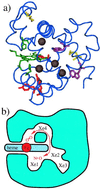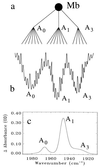The role of structure, energy landscape, dynamics, and allostery in the enzymatic function of myoglobin
- PMID: 11226246
- PMCID: PMC30145
- DOI: 10.1073/pnas.041614298
The role of structure, energy landscape, dynamics, and allostery in the enzymatic function of myoglobin
Abstract
The grail of protein science is the connection between structure and function. For myoglobin (Mb) this goal is close. Described as only a passive dioxygen storage protein in texts, we argue here that Mb is actually an allosteric enzyme that can catalyze reactions among small molecules. Studies of the structural, spectroscopic, and kinetic properties of Mb lead to a model that relates structure, energy landscape, dynamics, and function. Mb functions as a miniature chemical reactor, concentrating and orienting diatomic molecules such as NO, CO, O(2), and H(2)O(2) in highly conserved internal cavities. Reactions can be controlled because Mb exists in distinct taxonomic substates with different catalytic properties and connectivities of internal cavities.
Figures




References
-
- Antonini E, Brunori M. Hemoglobin and Myoglobin in their Reactions with Ligands. Amsterdam: North–Holland; 1971.
-
- Murad F. Angew Chem Int Ed. 1999;38:1856–1868. - PubMed
-
- Furchgott R F. Angew Chem Int Ed. 1999;38:1870–1880. - PubMed
-
- Ignarro L J. Angew Chem Int Ed. 1999;38:1882–1892. - PubMed
-
- Snyder S H, Jaffrey S R, Zakhary R. Brain Res Rev. 1998;26:167–175. - PubMed
Publication types
MeSH terms
Substances
Grants and funding
LinkOut - more resources
Full Text Sources
Other Literature Sources
Miscellaneous

